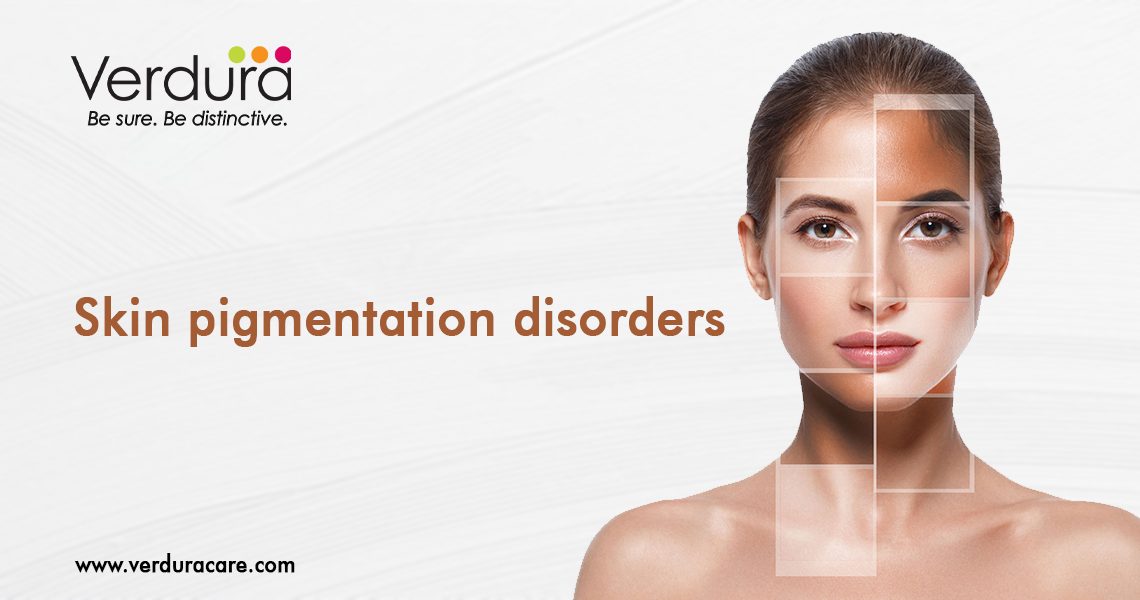

Pigmentation refers to the coloring of the skin. Melanin is the pigment responsible for skin color. Melanin acts as a protective barrier against the harmful effects of ultraviolet (UV) rays. Melanin offers antioxidant activity by scavenging for reactive oxygen species produced via UV.
What happens if you don’t have enough melanin?
Melanin in excess – Hyperpigmentation
Melanin in scarce – Hypopigmentaion

Melanin in scarce – Hypopigmentaion
Vitiligo – An auto-immune condition with lack of skin color in patches
Symptoms
Vitiligo signs include:
- Patchy loss of skin color, which usually first appears on the hands, face, and areas around body openings and the genitals
- Premature whitening or graying of the hair on your scalp, eyelashes, eyebrows or beard
- Loss of color in the tissues that line the inside of your mouth and nose (mucous membranes)
Vitiligo can start at any age, but usually appears before age 30.

Depending on the type of vitiligo you have, it may affect:
- Nearly all skin surfaces. With this type, called universal vitiligo, the discoloration affects nearly all skin surfaces.
- Many parts of your body. With this most common type, called generalized vitiligo, the discolored patches often progress similarly on corresponding body parts (symmetrically).
- Only one side or part of your body. This type, called segmental vitiligo, tends to occur at a younger age, progress for a year or two, then stop.
- One or only a few areas of your body. This type is called localized (focal) vitiligo.
- The face and hands. With this type, called acrofacial vitiligo, the affected skin is on the face and hands, and around body openings, such as the eyes, nose and ears.
It’s difficult to predict how your disease will progress. Sometimes the patches stop forming without treatment. In most cases, pigment loss spreads and eventually involves most of your skin. Occasionally, the skin gets its color back.
Albinism – A genetic condition with lack of skin color all over the body
Symptoms
Signs and symptoms of albinism involve skin, hair, and eye color and vision.
Skin
The most recognizable form of albinism results in white hair and very light-colored skin compared with siblings. Skin coloring (pigmentation) and hair color can range from white to brown, and may be nearly the same as that of parents or siblings without albinism.
With exposure to the sun, some people may develop:
- Freckles
- Moles, with or without pigment — moles without pigment are generally pink-colored
- Large freckle-like spots (lentigines)
- Sunburn and the inability to tan
For some people with albinism, skin pigmentation never changes. For others, melanin production may begin or increase during childhood and the teen years, resulting in slight changes in pigmentation.
Hair
Hair color can range from very white to brown. People of African or Asian descent who have albinism may have hair color that’s yellow, reddish or brown. Hair color may also darken by early adulthood or stain from exposure to normal minerals in water and the environment, and appear darker with age.
Eye color
Eyelashes and eyebrows are often pale. Eye color can range from very light blue to brown and may change with age.
The lack of pigment in the colored part of the eyes (irises) makes the irises somewhat translucent. This means that the irises can’t completely block light from entering the eye. Because of this, very light-colored eyes may appear red in some lighting.

Melanin in excess – Hyperpigmentation
Melasma –Grey-brown patches appear on the cheeks, forehead, nose and chin
Melasma appears in six locations or a combination of locations on your skin:
- Brachial: The melasma appears on your shoulders and upper arms.
- Centrofacial: The melasma appears on your forehead, cheeks, nose and upper lip.
- Lateral cheek pattern: The melasma appears on both cheeks.
- Malar: The melasma appears on your cheeks and nose.
- Mandibular: The melasma appears on the jawline.
- Neck: In people age 50 or older, melasma can appear on all sides of the neck.

Lentigines – Sharply circumscribed, pigmented macule surrounded by normal-appearing skin
Lentigines, or liver spots, are benign lesions that occur on the sun-exposed areas of the body. The backs of hands and face are common areas. The lesions tend to increase in number with age, making them common among the middle age and older population. They can vary in size from 0.2 to 2 cm.
Lentigo causes flat spots to appear on the body. These spots are usually tan, brown, or black in color. They may have rounded or uneven edges. Lentigines can appear on different areas of your body, depending on their cause.

Various products that give the following benefits are majorly used for treating vitiligo or hypopigmentary disorders of skin:
- Increases in melanin synthesis by skin cells
- Helps in the transfer of melanin from basal layer to the upper layer of skin
- And also induces the functionality of the required enzyme, tyrosinase
These functions are further enhanced by the sun therapy or PUVA therapy. But, due to lack of melanin, the vitiligenous skin becomes very sensitive to the sun exposure. Hence it needs to be protected from the sun damage.
Verdura mela gain cream- what and why
Verdura mela gain cream gives all the above mentioned benefits and helps in the management of vitiligo condition.
It also contains Psoralea corylifolia (natural source of Psoralen) that entraps and boosts the sun therapy and the sun screeners such as Bentonite, Calamine, Titanium dioxide and Zinc oxide that are present in it, give required protection to the skin from over exposure.

Clinical proof for efficacy of Verdura mela gain cream
A clinical study was done on 26 volunteers with cream with and without sun screeners and with and without sun exposure.
The findings of the study suggest that the herbal actives of the cream induce melanin production, irrespective of sun exposure. Simultaneously, the sunscreeners minimize the solar vulnerability of the skin.
Hence, with these proven complimentary benefits from contradicting agents, Verdura mela gain cream can be the best product of choice for vitiligo treatment.



